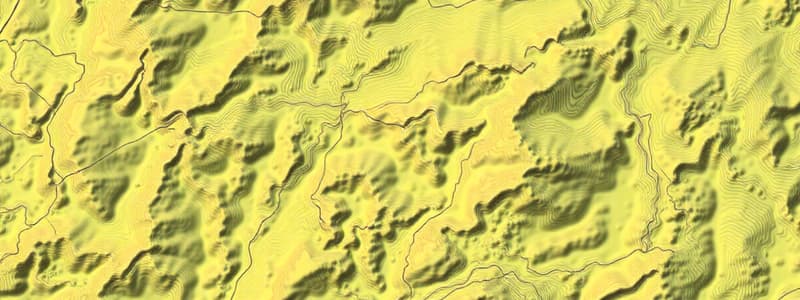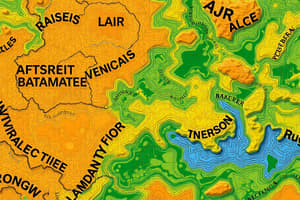Podcast
Questions and Answers
What does a topographic map primarily illustrate?
What does a topographic map primarily illustrate?
- The historical significance of the land
- The social demographics of the area
- Surface features, slopes, and contours of land (correct)
- The economic value of the land
How is slope typically expressed?
How is slope typically expressed?
- As an absolute measurement in feet
- As an average of all height measurements
- As a fraction of vertical rise to horizontal run (correct)
- As a percentage of total area
Which slope range is classified as 'strongly rolling'?
Which slope range is classified as 'strongly rolling'?
- 30-50%
- 18-30% (correct)
- 0-3%
- 8-18%
What is the purpose of slope analysis in topography?
What is the purpose of slope analysis in topography?
What does a contour interval indicate on a topographic map?
What does a contour interval indicate on a topographic map?
What primary function does a land use map serve?
What primary function does a land use map serve?
Which factor is NOT considered when assessing a parcel's suitability for development?
Which factor is NOT considered when assessing a parcel's suitability for development?
What does a zoning ordinance primarily govern?
What does a zoning ordinance primarily govern?
Which type of map provides a detailed distribution of land uses within urban zones?
Which type of map provides a detailed distribution of land uses within urban zones?
When considering demographic information, which aspect is not typically analyzed?
When considering demographic information, which aspect is not typically analyzed?
What is a necessary consideration for structures built on steep slopes?
What is a necessary consideration for structures built on steep slopes?
What is typically required when a project is within a residential subdivision?
What is typically required when a project is within a residential subdivision?
Which of the following is not an advantage of rolling terrain in site development?
Which of the following is not an advantage of rolling terrain in site development?
Which of the following is NOT a key assessment in evaluating existing sewer and water capacity?
Which of the following is NOT a key assessment in evaluating existing sewer and water capacity?
What is the maximum permitted slope angle for pedestrian ramps?
What is the maximum permitted slope angle for pedestrian ramps?
In terms of drainage, what should be ensured for effective site development?
In terms of drainage, what should be ensured for effective site development?
Which zoning component typically indicates the locations where specific land use types are allowed?
Which zoning component typically indicates the locations where specific land use types are allowed?
For streets and drives, what is the range of the permitted slope angle?
For streets and drives, what is the range of the permitted slope angle?
What role do public transit lines play in land use planning?
What role do public transit lines play in land use planning?
In assessing historical elements, what is the main concern for planners?
In assessing historical elements, what is the main concern for planners?
What distinguishes wetlands from other landforms?
What distinguishes wetlands from other landforms?
Which of the following statements about floodplains is correct?
Which of the following statements about floodplains is correct?
How are aquifer recharge areas significant in hydrogeology?
How are aquifer recharge areas significant in hydrogeology?
Which characteristic is NOT typically found on hydrogeologic maps?
Which characteristic is NOT typically found on hydrogeologic maps?
Which factor is NOT considered a macro-climate factor?
Which factor is NOT considered a macro-climate factor?
What is a critical consideration when analyzing existing vegetation before development?
What is a critical consideration when analyzing existing vegetation before development?
Which of the following defines endemic species?
Which of the following defines endemic species?
What is the minimum easement requirement for urban areas alongside waterways as prescribed by the Water Code?
What is the minimum easement requirement for urban areas alongside waterways as prescribed by the Water Code?
What challenges are commonly associated with irregular building shapes on a site?
What challenges are commonly associated with irregular building shapes on a site?
Which type of street pattern is characterized by a straight road with infrequent crossings?
Which type of street pattern is characterized by a straight road with infrequent crossings?
In the context of site configuration, which building arrangement is described as cohesive and prevents alienation between elements?
In the context of site configuration, which building arrangement is described as cohesive and prevents alienation between elements?
What is one disadvantage of a gridiron street pattern?
What is one disadvantage of a gridiron street pattern?
What role does a monument or statue serve in a building's site configuration?
What role does a monument or statue serve in a building's site configuration?
What is the primary focus of site planning?
What is the primary focus of site planning?
Which aspect is NOT considered a primary factor in site and physical planning?
Which aspect is NOT considered a primary factor in site and physical planning?
In site selection and analysis, what is the main goal?
In site selection and analysis, what is the main goal?
Comprehensive land and water use planning (CLWUPS) is primarily related to what type of planning?
Comprehensive land and water use planning (CLWUPS) is primarily related to what type of planning?
What does subdivision planning typically involve?
What does subdivision planning typically involve?
What is a key element of Master Development Planning (MDP)?
What is a key element of Master Development Planning (MDP)?
Which of the following best describes site design?
Which of the following best describes site design?
State housing policies typically address which of the following?
State housing policies typically address which of the following?
What is the implication of a slope above 18% in land use planning?
What is the implication of a slope above 18% in land use planning?
What is the main objective of view analysis in architectural design?
What is the main objective of view analysis in architectural design?
What minimum slope is required for proper drainage and sewage systems?
What minimum slope is required for proper drainage and sewage systems?
Which factor is NOT considered when determining building orientation?
Which factor is NOT considered when determining building orientation?
Which type of geology primarily deals with landform origin and erosion processes?
Which type of geology primarily deals with landform origin and erosion processes?
What characteristic of soils affects their suitability for building foundations?
What characteristic of soils affects their suitability for building foundations?
How can undesirable noises be effectively controlled in building design?
How can undesirable noises be effectively controlled in building design?
Which of the following types of rock forms through cooling magma?
Which of the following types of rock forms through cooling magma?
Why is it important to consider the angle of vertical views in building design?
Why is it important to consider the angle of vertical views in building design?
In the context of the atlas-CDC architecture review, what is the role of bedrock in site evaluation?
In the context of the atlas-CDC architecture review, what is the role of bedrock in site evaluation?
What does the concept of view corridors mainly relate to?
What does the concept of view corridors mainly relate to?
What is the significance of siting in architecture?
What is the significance of siting in architecture?
Which of the following methods can potentially help control soil erosion?
Which of the following methods can potentially help control soil erosion?
Which noise control method involves completely blocking residential levels from the road?
Which noise control method involves completely blocking residential levels from the road?
For parking lots, what is the maximum allowable slope to ensure safety and functionality?
For parking lots, what is the maximum allowable slope to ensure safety and functionality?
What role do plants play in building orientation concerning sun and wind?
What role do plants play in building orientation concerning sun and wind?
Which statement about cul-de-sacs is accurate?
Which statement about cul-de-sacs is accurate?
In which scenario would a combination layout be most appropriately utilized?
In which scenario would a combination layout be most appropriately utilized?
What is a potential disadvantage of loop street designs?
What is a potential disadvantage of loop street designs?
Which attribute does not describe modified grids?
Which attribute does not describe modified grids?
Radial street layouts are characterized by what key feature?
Radial street layouts are characterized by what key feature?
What is a key characteristic of local streets?
What is a key characteristic of local streets?
Which grading method minimizes erosion and settling?
Which grading method minimizes erosion and settling?
What is an advantage of the combining cut-and-fill method?
What is an advantage of the combining cut-and-fill method?
Which method is most suitable for computing volumes of water in ponds?
Which method is most suitable for computing volumes of water in ponds?
What is a disadvantage of grading by fill?
What is a disadvantage of grading by fill?
Which type of roads primarily provides unity throughout contiguous urban areas?
Which type of roads primarily provides unity throughout contiguous urban areas?
What role does site grading play in building and land relationships?
What role does site grading play in building and land relationships?
What type of streets would typically only open at one end with a turnaround at the other?
What type of streets would typically only open at one end with a turnaround at the other?
Flashcards
Topographic map
Topographic map
A map that shows the shape and elevation of the land's surface.
Contour lines
Contour lines
Lines on a topographic map that connect points of equal elevation.
Contour interval
Contour interval
The vertical distance between two contour lines.
Slope
Slope
Signup and view all the flashcards
Slope analysis
Slope analysis
Signup and view all the flashcards
Geomorphology
Geomorphology
Signup and view all the flashcards
Bedrock
Bedrock
Signup and view all the flashcards
Runoff
Runoff
Signup and view all the flashcards
Soils
Soils
Signup and view all the flashcards
Hydrogeology
Hydrogeology
Signup and view all the flashcards
Physiography
Physiography
Signup and view all the flashcards
Soil Erosion Control
Soil Erosion Control
Signup and view all the flashcards
Master Development Planning (MDP)
Master Development Planning (MDP)
Signup and view all the flashcards
Site Planning
Site Planning
Signup and view all the flashcards
Site Selection and Analysis
Site Selection and Analysis
Signup and view all the flashcards
Site Development Planning (SDP)
Site Development Planning (SDP)
Signup and view all the flashcards
Zoning Ordinances (ZOs)
Zoning Ordinances (ZOs)
Signup and view all the flashcards
Comprehensive Land and Water Use Planning (CLWUPS)
Comprehensive Land and Water Use Planning (CLWUPS)
Signup and view all the flashcards
Urban and Regional Planning
Urban and Regional Planning
Signup and view all the flashcards
Site Utilization and Land-Use Studies
Site Utilization and Land-Use Studies
Signup and view all the flashcards
View analysis
View analysis
Signup and view all the flashcards
Natural features
Natural features
Signup and view all the flashcards
Views and Visual Barriers
Views and Visual Barriers
Signup and view all the flashcards
View Corridor and Sightlines
View Corridor and Sightlines
Signup and view all the flashcards
Siting
Siting
Signup and view all the flashcards
Sun and Wind Orientation
Sun and Wind Orientation
Signup and view all the flashcards
Noise Evaluation
Noise Evaluation
Signup and view all the flashcards
Noise Control Methods
Noise Control Methods
Signup and view all the flashcards
General Land Use Map
General Land Use Map
Signup and view all the flashcards
Urban Land Use Map
Urban Land Use Map
Signup and view all the flashcards
Urban Land Use Plan (or Proposed Land Use Map)
Urban Land Use Plan (or Proposed Land Use Map)
Signup and view all the flashcards
Zoning Ordinances
Zoning Ordinances
Signup and view all the flashcards
Zoning Map
Zoning Map
Signup and view all the flashcards
Demographic Information Analysis
Demographic Information Analysis
Signup and view all the flashcards
Existing Sewers and Water Capacity Assessment
Existing Sewers and Water Capacity Assessment
Signup and view all the flashcards
Road Access and Capacity Assessment
Road Access and Capacity Assessment
Signup and view all the flashcards
Identifying Historical and Cultural Elements
Identifying Historical and Cultural Elements
Signup and view all the flashcards
Utilities Mapping and Assessment
Utilities Mapping and Assessment
Signup and view all the flashcards
Flood Hazard Map
Flood Hazard Map
Signup and view all the flashcards
Wetlands
Wetlands
Signup and view all the flashcards
Floodplain
Floodplain
Signup and view all the flashcards
River Basin
River Basin
Signup and view all the flashcards
Easement
Easement
Signup and view all the flashcards
Endemic Species
Endemic Species
Signup and view all the flashcards
Climate
Climate
Signup and view all the flashcards
Slope Angle
Slope Angle
Signup and view all the flashcards
Steep Slope Development
Steep Slope Development
Signup and view all the flashcards
Land Development Scenarios
Land Development Scenarios
Signup and view all the flashcards
Rolling Terrain Design
Rolling Terrain Design
Signup and view all the flashcards
Building Shape and Site Form
Building Shape and Site Form
Signup and view all the flashcards
Challenges of Irregular Building Shapes
Challenges of Irregular Building Shapes
Signup and view all the flashcards
Gridiron Street Patterns
Gridiron Street Patterns
Signup and view all the flashcards
Linear/Street Ribbon
Linear/Street Ribbon
Signup and view all the flashcards
Isolated Building
Isolated Building
Signup and view all the flashcards
Radial Street Layout
Radial Street Layout
Signup and view all the flashcards
Meandering Street Layout
Meandering Street Layout
Signup and view all the flashcards
Cul-de-Sac
Cul-de-Sac
Signup and view all the flashcards
Combination Street Layout
Combination Street Layout
Signup and view all the flashcards
Loop Street Layout
Loop Street Layout
Signup and view all the flashcards
Major Roads
Major Roads
Signup and view all the flashcards
Collector Streets
Collector Streets
Signup and view all the flashcards
Secondary Roads
Secondary Roads
Signup and view all the flashcards
Local Streets
Local Streets
Signup and view all the flashcards
Site Grading
Site Grading
Signup and view all the flashcards
Grading by Fill
Grading by Fill
Signup and view all the flashcards
Grading by Cut
Grading by Cut
Signup and view all the flashcards
Combining Cut-and-Fill
Combining Cut-and-Fill
Signup and view all the flashcards




